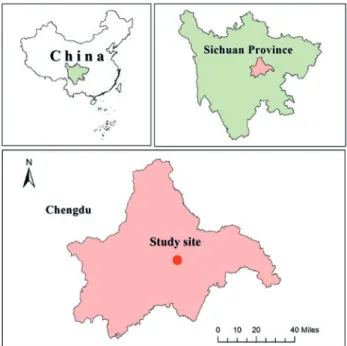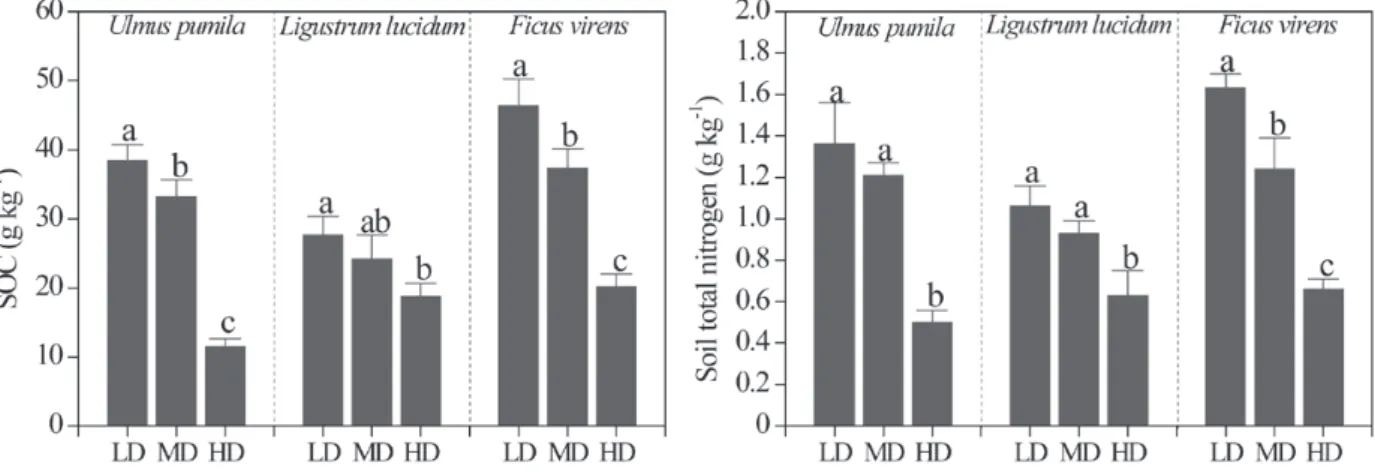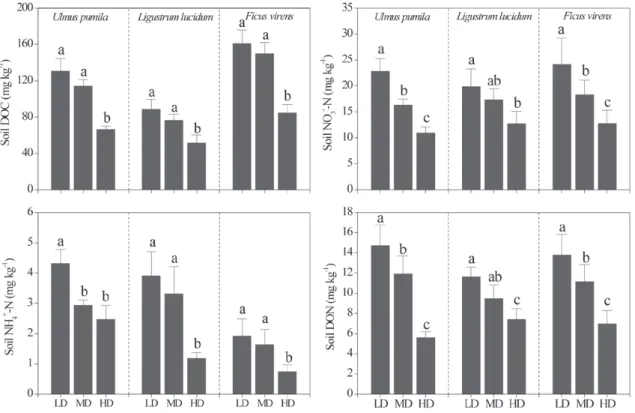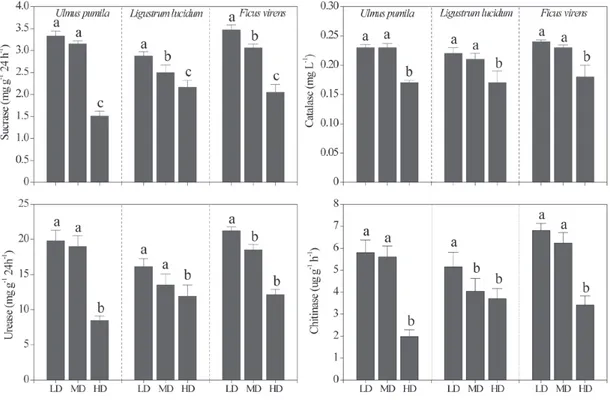SUMMARY
This study investigated the effects of different tourism disturbance intensities on carbon, nitrogen, and enzyme activities of soil in a subtropical urban park, China. The contents of the soil organic carbon (SOC), total nitrogen (TN), dissolved organic carbon (DOC), dissolved organic nitrogen (DON), nitrate nitrogen (NO3-–N), and am-monium nitrogen (NH4+–N) in the soil were significantly reduced by tourism disturbance. The activities of some soil enzymes, including sucrase, catalase, urease, and chitinase, were also reduced. Except for NH4+–N, the soil carbon–nitrogen indicators all exhibited significant positive correlations with the four soil enzyme activities. The results indicated that tourism disturbance caused soil degradation in the subtropical urban park. Therefore, the soil in damaged areas should be frequently turned up, and more organic fertilizers should be added.
KEY WORDS: tourism disturbance, subtropical urban park, soil carbon and carbon, enzyme activity
INFLUENCE OF TOURISM DISTURBANCE
ON CARBON, NITROGEN, AND ENZYME
ACTIVITIES OF THE SOIL IN AN URBAN PARK
IN CHINA
UTJECAJ TURIZMA NA AKTIVNOST UGLJIKA, DUŠIKA
I ENZIMA U TLU U URBANOM PARKU U KINI
Xiaoyang ZENG
INTRODUCTION
UVOD
People enjoy spending time in urban parks, especially those with abundant vegetation. Such locations are re-laxing and enjoyable. However, frequent visitation can negatively impact the local area by harming the ecologi-cal environment of the park. It can lead to destroyed ve-getation and increased soil hardness. Naturally, as urba-nization and tourism continue to grow, the environmental effects of tourism have become increasin-gly obvious. As a result, society is paying more attention to these issues, and it has become a hot topic in current
ecological tourism research (Sun et al., 2014; Svajda et al., 2016).
An important component of ecological tourism research is investigating the effect of tourism on soil. Such research first began in the 1960s and has primarily concentrated on the effects of different trampling intensities and tram-pling types on soil organic matter, soil physical properties, and plant diversity (Deluca et al., 1998; Lu et al., 2011; Svajda et al., 2016; Wen et al., 2016). Nonetheless, only a few reports are available on the influence of tourism ac-tivities on soil biological properties (Gong et al., 2009; Li et al., 2015). This study aimed to investigate the influence
* Dr. Xiaoyang Zeng, Department of Landscape Architecture, Sichuan College of Architectural Technology, Chengdu 610081, China Correspondence author’s e-mail: zengxy@sina.cn
culated from multiple years’ records is 16.2 oC. The annual maximum and minimum temperatures are 37.3 oC and - 5.9 oC, respectively. The mean annual number of sunshine hours is 1071 hous. The mean annual precipitation is 945.6 mm, and the annual frost-free period is above 337 days. It is warm year-round, and the four seasons are distinct. The soil in the study area is referred to as purple soil and classi-fied as Pup-Orthic Entisols in the Chinese soil taxonomy and Eutric Regosol in the Food and Agriculture Organization’s Soil Classification. Chengdu is a mid-subtro-pical region, and the main type of vegetation is that of the subtropical evergreen broad-leaved forest.
Experimental setup – Plan pokusa
The experiment was conducted in September 2016 in Hua-nhuaxi Park in Chengdu. The location of this park is shown in Figure 1. Three common types of plant commu-nities were chosen, whose dominant species are Ulmus pumila L., Ligustrum lucidum, and Ficus virens, respec-tively. For each sample plot of the plant communities, the sightseeing road of the scenic area was taken as the center, and three parallel belt transects were set along the vertical direction to one side of the sightseeing road (close to the side with more plant trampling), and the spacing between
each transect was more than 5 meters (Figure 2). The start-ing point of the belt transect was located at the edge of the sightseeing road, and quadrates of 1 m×1 m were set at 1 m, 5 m, and 10 m away from the sightseeing road, repre-senting heavy, moderate, and light tourism disturbances, respectively (Figure 2). Three quadrates with the same dis-tance from the starting point distributed on three parallel belt transects were considered as three sampling replicates. In each quadrate, a 5 cm-diameter soil borer was used, and five random drills of soil within the range of 0 - 15 cm were collected. The five samples were then mixed to form one composite sample of about 1 kg. The soil was passed through a 2 mm sieve and then divided into two parts (Tian et al., 2017). One part of the soil was air-dried and ground to pass through a 0.2 mm sieve to test the soil or-Figure 1. Location of the study site.
Slika 1. Lokalitet istraživanja
Figure 2. Sampling scheme. Sampling quadrate 1, 2 and 3 on the belt transect represent heavy, moderate, and light tourism disturbances, re-spectively.
ganic carbon (SOC) and total nitrogen (TN) of the soil. The other part was refrigerated at 4 oC to test soil organic carbon (DOC), nitrate nitrogen (NO3–—N), ammonium nitrogen (NH4+–N), dissolved organic nitrogen (DON), and soil enzyme activity.
Laboratory Analyses – Laboratorijske analize
The presence of SOC was tested by the Walkley-Black met-hod (Lu, 1999). Soil TN was measured using the micro-Kjeldahl method (Lu, 1999). Soil DOC, NO3-–N, NH4+–N, and DON were extracted with 2 M KCl for 1 h, and the concentrations were determined by a continuous flow au-toanalyzer (Skalar San++ 8505, Netherlands). The sucrase and urease activities in the soil were assayed based on the release and quantitative determination of the products of glucose and NH4+–N. Soil samples were incubated with an 8% sucrose solution and a 10% urea solution in a suitable buffer solution for 24 h at 37 oC, and spectrophotometric measurements were performed (Xu and Zheng, 1986). Ca-talase activity was measured using the 0.1N KMnO4 titra-tion method (Xu and Zheng, 1986). Chitinase activity was determined by incubating a mixture of toluene-treated soil
with 1 % (weight/weight) colloidal chitin suspension for 1 h at 37 oC and then, after dilution, assaying the amount of N-acetyl-glucosamine released (Chen et al., 1994).
Statistical analyses – Statističke analize
Statistical analyses were performed using SPSS 16.0 (SPSS Inc., Chicago, USA). All data were checked for normality of distributions and homogeneity of variances prior to analysis. Two-way analysis of variance was used to deter-mine the effects of vegetation type and tourism disturbance on soil variables. Least significant difference tests were used to compare the means between different tourism distur-bance intensities. Pearson correlation coefficients were also utilized to evaluate the relationships among corresponding variables. A p-value < 0.05 was considered significant.
RESULTS AND DISCUSSION
REZULTATI I RASPRAVA
In the three sample plots of the plant community, the hea-vily disturbed soil had an obviously lower organic carbon content than the mildly disturbed soil (p<0.05), and the re-Figure 1. Soil organic carbon and total nitrogen under different tourism disturbance intensities in a subtropical park. LD, MD and HD represent heavy, moderate, and light tourism disturbances.
Slika 1. Udjel organskog ugljika i ukupnog dušika u tlu pod djelovanjem različitih intenziteta turističke djelatnosti u tri vegetacijske zajednice u suptropskom parku. LD, MD i HD predstavljaju lagani, umjereni i jaki intenzitet turističke aktivnosti.
Table 1. Two-way ANOVAs of soil carbon/nitrogen as affected by vegetation and tourism disturbance in subtropical urban park
Tablica 1. Dvosmjerna analiza varijance (ANOVA) ugljika/dušika tla pod djelovanjem vegetacije i turizma u suptropskom urbanom parku
SOC TN DOC NO3--N NH4+-N DON SUC CAT URE CHI
V 0.154 0.163 0.009 0.055 0.010 0.257 0.533 0.033 0.313 0.317
T 0.023 0.009 0.008 0.006 0.014 0.008 0.023 < 0.001 0.029 0.035
V×T < 0.001 < 0.001 0.021 0.111 0.204 0.034 < 0.001 0.623 < 0.001 < 0.001
V: Vegetation; T: Tourism; TC: Total C; TN: Total N; DOC: Dissolved organic carbon; DON: Dissolved organic nitrogen; SUC: Sucrase; CAT: Catalase ; URE: Urease; CHI: Chitinase.
V: vegetacija; T: turizam; TC: ukupni ugljik; TN: ukupni dušik; DOC: otopljeni organski ugljik; DON: otopljeni organski dušik; SUC: sukraza; CAT: katalaza; URE: ureaza; CHI: hitinaza
pacted soil negatively impacts the growth and development of plant roots, thus leading to reduced plant return. These effects cause the organic matter content to decrease (Lu et al., 2011). The soil nitrogen is closely related to the organic matter content. Thus, when tourism disturbances reduce the organic matter content, the nitrogen content of the soil is likewise reduced (Gong et al., 2009).
The severely disturbed soil had significantly lowerDOC than both the moderately and mildly disturbed soils, but the difference in the DOC content between the latter two soils was not significant (Figure 2). DOC is the main com-ponent of soil organic matter, which is derived mainly from plant litter and the decomposition of humus, microbial
bi-et al., 2016). As tourism disturbance reduces the TN con-tent in the soil, the mineralization source of NO3-–N and NH4+–N also decreases. Furthermore, tourism trampling increases the soil density and reduces the soil moisture, which weakens the microbial activities in the soil and then reduces soil mineralization and nitrification (Li et al., 2015). Additionally, the severe disturbance also significantly lowe-red the soil DON content. The source of soil DON is same as that of soil DOC. The decreased DON content was pro-bably primarily caused by decreases in vegetation coverage and litter as a result of severe disturbance, as is suggested in the work of other researchers (Ueda et al., 2013; Mobley et al., 2014).
Figure 2. Soil DOC, NO3-–N, NH4+–N, and DON content under different tourism disturbance intensities in a subtropical park. LD, MD and HD
rep-resent heavy, moderate, and light tourism disturbances.
Slika 2. Udjel DOC, NO3-–N, NH4+–N i DON tla pod djelovanjem različitih intenziteta turističke djelatnosti u tri vegetacijske zajednice u suptropskom parku.
In the three sample plots of the plant community, the hea-vily disturbed soil had significantly lower sucrase, catalase, urease, and chitinase activities than the lightly disturbed soil (Figure 3, Table 2). Sucrase enzyme activity showed si-gnificant differences between lightly and moderately distur-bed soils between treatments in both Ligustrum lucidum and Ficus virens communities (Figure 3). No significant changes were observed in catalase activity between lightly and moderately disturbed soils in the three plant commu-nities, and significant differences were noted in urease and chitinase activities between mildly and moderately distur-bed soils in both L. lucidum and F. virens communities (Fi-gure 3). These results indicate that the sucrase enzyme is most sensitive to tourism disturbance and the catalase enzyme is the least.
Each of the enzymes examined in this study can act as im-portant indicators of certain soil characteristics. For exam-ple, the sucrase enzyme is highly significant because it can be used to characterize the carbon cycle and microbial me-tabolic activity of soil (Li et al., 2015; Tomkiel et al., 2015). It is able to reflect the transformation rules concerning accumulation and decomposition of SOC (Sumathi and Thaddeus, 2013; Li, 2015). Tourism disturbance decreases the soil sucrase activity, indicating that the transformation of organic matter in soil decreases with increasing distur-bance intensity. The decreased mineralization of plant litter,
root exudates, and roots in turn reduce the soil organic matter and the soil sucrase transformational substrate. As for catalase, it is an indicator of the microbial oxidation re-duction system and thus can characterize the microbial oxi-dizing ability of microorganisms in the soil (Tomkiel et al., 2015). Compared with lightly disturbed soils, catalase was usually lower in the moderately and heavily disturbed soils in this study, which might be because tourism disturbance suppresses the growth and reproduction of microorganisms and reduces the catalase source to a certain extent. Finally, urease and chitinase enzymatic activities can contribute to the soil nitrogen cycle and related soil activities, which are affected by soil nitrogen availability (Dindar et al., 2015). Tourism disturbance destroys the litter layer and the humus layer, decreases the soil organic matter, and reduces the soil nitrogen content, urease activity, and chitinase activity. Furthermore, severe tourism disturbance results in com-pacted and exposed soil and changes the hydrothermal con-ditions of the soil, which is not beneficial for soil microbial abilities, and thus, urease activity and other enzyme activi-ties decrease (Li 2015; Tomkiel et al., 2015).
The correlational analyses between the soil carbon and ni-trogen forms and soil enzyme activities show that all, except NH4+–N, exhibit significant positive correlations with sucrase, catalase, urease, and chitinase activity (Table 2). The close relationship between soil carbon and nitrogen Figure 3. Soil enzyme activities under different tourism disturbance intensities in a subtropical park. LD, MD and HD represent heavy, moderate, and light tourism disturbances.
Slika 3. Aktivnosti enzima tla pod djelovanjem različitih intenziteta turističke djelatnosti u tri vegetacijske zajednice u suptropskom parku. LD, MD i HD predstavljaju lagani, umjereni i jaki intenzitet turističke aktivnosti.
and soil enzyme activity implies that the latter can be an indicator for evaluating the effectiveness of soil carbon and nitrogen turnover. The soil ecological environment is a complete system in which the factors directly affect each other. Thus, each factor that is changed by tourism activity would in turn impact the entire ecological environment.
CONCLUSIONS
ZAKLJUČCI
This research reveals that tourism disturbance significantly reduces the soil carbon–nitrogen effectiveness and soil enzyme activities of a subtropical urban park. Consequ-ently, the matter cycle and transformation intensity in the soil are also affected. Furthermore, plant growth is restric-ted, which significantly impacts the ecological system (Wen et al., 2016). As a result of this study, several suggestions are proposed. Firstly, some warning signs should be placed in vegetation areas that are home to large-scale human activi-ties to remind visitors not to trample upon and destroy the trees and flowers. Secondly, the soil in areas disturbed by tourism should be turned up frequently, and the addition of fertilizers is necessary. Thirdly, in damaged areas, fast-growing trees and shrubs should be planted. Lastly, ecolo-gical engineering needs to be strengthened to promote an ecologically-conscious tourism industry.
ACKNOWLEDGMENTS
ZAHVALE
This research was supported by the foundation of Sichuan Educational Committee (18ZB0400), the technology support program of Deyang city (2017ZZ043), the founda-tion of Sichuan College of Architectural Technology (SCJY/ RC–KY–07). The author greatly appreciates two anonymous reviewers for their constructive comments and suggestions
on an earlier version of the manuscript. The author is very much obliged to Mrs. Ljerka Vajagić for translation of En-glish to Croatian.
REFERENCES
LITERATURA
• Chen, K.S., K.K. Lee, H.C. Chen, 1994: A rapid method for de-tection of N-acetylglucosaminidase-type chitinase activity in crossed immunoelectrophoresis and sodium dodecyl sulfate-polyacrylamide gel electrophoresis gels using 4-methylumbel-liferyl-N-acetyl-D-glucosaminide as substrate, Electrophoresis, 15(5): 662–665.
• Deluca, T.H., W.A. Patterson, W.A. Freimund, D.N. Cole, 1998: Influence of lamas, horses, and hikers on soil erosion from es-tablished recreation trails in western Montana, USA, Environ-mental Management, 22(2): 255–262.
• Dindar, E., F.O. Sagban, H.S. Baskaya, 2015: Evaluation-of soil enzyme activities as soil quality indicators in sludge-amended soils, Journal of Environmental Biology, 36(4): 919–926. • Gong, J., L. Lu, X.L. Jin, W. Nan, F. Liu, 2009; Impacts of
tour-ist dtour-isturbance on plant communities and soil properties in Huangshan Mountain scenic area, Acta Ecologica Sinica, 29: 2239–2251.
• Li, W.L., 2015: Impacts of tourist disturbance on soil enzyme activity and water quality in Poyang Lake national wetland park, Research of Soil and Water Conservation, 22(3): 62–66. • Lu, L., J. Gong, X.L. Jin, 2011: Impacts of tourist disturbance on
soil in Huangshan Mountain scenic area, Geographical Re-search, 30(2): 209–223.
• Lu, R.K., 1999: Soil and Agro-chemical Analytical Methods, China Agricultural Science and Technology Press, Beijing, China.
• Mobley, M.L., M.J. Cleary, I.C. Burke, 2014: Inorganic Nitrogen Supply and Dissolved Organic Nitrogen Abundance across the US Great Plains, PLoS ONE 9: e107775.
• Qin, Y.H., D.T. Xie, C.F. Wei, 2006: Study on responses of soil ecological environment to impacts of tourist activities, Journal of Soil and Water Conservation, 20(3): 61–65.
URE 0.964**
** p - value <0.01. ** p - vrijednost <0.01.
• Sumathi G., A. Thaddeus, 2013: Impact of organic rich diet on gut enzymes, microbes and biomass of earthworm, Eudrilus eugienea, Journal of Environmental Biology, 34(3): 515–520. • Sun, J.K., J.H. Zhang, J.H. Man, J. Zhou, J. Chen, L. Yang, 2014:
Progress and enlightenment of research on tourism environ-ment carrying capacity in the past decade, Geography and Geo-Information Science, 30(2): 86–91.
• Svajda, J., S. Korony, I. Brighton, S. Esser, S. Ciapala, 2016: Trail impact monitoring in Rocky Mountain National Park, USA, Solid Earth, 7: 115–128.
• Tian, H., H. Wang, X.L., Hui, Z.H., Wang, R.A., Drijber, J.S., Liu, 2017. Changes in soil microbial communities after 10 years of winter wheat cultivation versus fallow in an organic-poor soil in the Loess Plateau of China, Plos ONE, 12(9): e0184223. • Tomkiel M., M. Bacmaga, J. Wyszkowska, J. Kucharski, A.
Borowik, 2015: The effect of carfentrazone-ethyl on soil
micro-organisms and soil enzymes activity, Archives of Environmen-tal Protection, 41(3): 3-10.
• Ueda M.U., O. Muller, M. Nakamura, T. Nakaji, T. Hiura, , 2013: Soil warming decreases inorganic and dissolved organic nitro-gen pools by preventing the soil from freezing in a cool temper-ate forest, Soil Biology and Biochemistry, 61(6): 105–108. • Wang, D.X., Y.H. Gao, P. Wang, X.Y. Zeng, 2016, Responses of
CO2 and N2O emissions to carbon and phosphorus additions in two contrasting alpine meadow soils on the Qinghai-Tibetan Plateau, Fresenius Environmental Bulletin, 25(10): 4401–44408. • Wen, B., X.L. Zhang, Z.P. Yang, H.G. Xiong, Q. Yang, 2016: In-fluence of tourist disturbance on soil properties, plant commu-nities, and surface water quality in the Tianchi scenic area of Xinjiang, China, Journal of Arid Land, 8(2): 304–313.
• Xu, G.H., H.Y. Zheng, 1986: Handbook of Analysis Methods of Soil Microbiology, Agricultural Press, Beijing, China.
SAŽETAK
U ovom se radu istražuju učinci različitih intenziteta turističke djelatnosti na aktivnost ugljika, dušika i enzima u tlu u suptropskom urbanom parku u Kini. Udjel organskog ugljika tla (SOC), ukupnog ili totalnog ugljika (TN), otopljenog organskog ugljika (DOC), otopljenog organskog ugljika (DON), ni-tratni oblik dušika (NO3-–N) i amonijski oblik dušika (NH4+–N). SOC, TN, DOC, NO3-–N i NH4+–N u tlu značajno je reduciran kao posljedica turističkih djelatnosti. Aktivnost pojedinih enzima, uključujući sukrazu, katalazu, ureazu i hitinazu, također je reducirana. S iznimkom NH4+-N, svi indi-katori ugljika-dušika u tlu pokazali su pozitivnu korelaciju s aktivnosti četiri enzima u tlu. Rezultati ukazuju da turistička djelatnost dovodi do degradacije tla u suptropskom urbanom parku te da je tlo u oštećenim područjima potrebno često preokretati i dodavati više organskih gnojiva.



